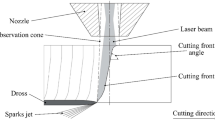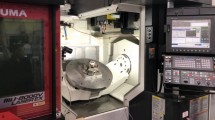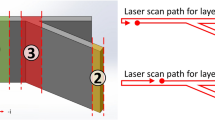Abstract
Nowadays, industrial laser cutting systems employ a fixed set of process parameters throughout the cut of the same workpiece, which results in a good compromise between maximum productivity and surface quality. The process parameters are commonly set by trial-and-error experiments carried out on different materials and thicknesses or less frequently by physical modelling. However, the final cut quality is not constant even though the process parameters are kept fixed due to degradation of the initial status of the laser cutting system. One of the common issues in the laser cutting process is the local heating of the optical components due to contamination and/or high powers commonly employed, which cause shifting of the focus position. This can worsen the cutting-edge quality, and even result with loss of cut. Therefore, the online measurement of the position of focus is a requirement for a consistent process. An empirical method used in the industrial practice for initially setting and successively examining and adjusting the focus position is to measure the kerf width of a straight-line cut performed with constant process parameters. This paper proposes an algorithm to monitor the kerf width and yield the estimated focus position in real-time during the cutting process. The kerf width is observed during the process with a coaxial camera module mounted on the laser head which monitors the thermal interaction between the laser beam and the material. An image processing algorithm was developed for extracting the kerf width from the acquired images, and the algorithm parameters were experimentally calibrated such that the extracted value of the kerf width matches with its physical measure. To understand the influence of the focus position on the cutting kerf, an experimental campaign was conducted and subsequently a regression model was fitted. The real-time monitoring and computation of the kerf width and its correlation to the focus position give the opportunity for a closed-loop control of the focus shift, that would eventually lead to a gain of process stability and repeatability.










Similar content being viewed by others
Data availability
The collected data required to reproduce the above findings cannot be shared at this time as the data is also used in an ongoing study.
References
Oh S, Lee I, Bin Park Y, Ki H (2019) Investigation of cut quality in fiber laser cutting of CFRP. Opt Laser Technol 113:129–140. https://doi.org/10.1016/j.optlastec.2018.12.018
Xing Y, Liu L, Wu Z, Wang X, Huang P, Tang L (2018) Fabrication and characterization of micro-channels on Al2O3/TiC ceramic produced by nanosecond laser. Ceram Int 44:23035–23044. https://doi.org/10.1016/j.ceramint.2018.09.106
Wadekar S, Deokar SU (2016) Effect of Process Parameters on Laser Cutting Process: A Review. Imp J Interdiscip Res 2(7):434–439
Sharifi M, Akbari M (2019) Experimental investigation of the effect of process parameters on cutting region temperature and cutting edge quality in laser cutting of AL6061T6 alloy. Optik (Stuttg) 184:457–463. https://doi.org/10.1016/j.ijleo.2019.04.105
Liu Y (2012) Optimization of cutting parameters in machining. Adv Mater Res 549:871–874. https://doi.org/10.4028/www.scientific.net/AMR.549.871
Karatas C, Keles O, Uslan I, Usta Y (2006) Laser cutting of steel sheets: Influence of workpiece thickness and beam waist position on kerf size and stria formation. J Mater Process Technol 172:22–29. https://doi.org/10.1016/j.jmatprotec.2005.08.017
T. ARAI, Generation of Striations During Laser Cutting of Mild Steel, SOP Trans. Appl. Phys. 2014 (2014) 81–95. 10.15764/aphy.2014.02010.
M.H. Mahdieh, H. Moradi, Experimental and Theoretical Investigations of Beam Deformation Produced by Thermal Lens Effect on a Gaussian Laser Beam in Ethanol, Lasers Manuf. Mater. Process. (2020). https://doi.org/10.1007/s40516-020-00116-0.
Tatzel L, León FP (2020) Impact of the thermally induced focus shift on the quality of a laser cutting edge. J Laser Appl 32:022022. https://doi.org/10.2351/7.0000053
Eiselen S, Zapf H, Mantel E, Hofmann L, Schmidt M (2012) Impact of thermal focal shift on laser cutting processes with high brightness lasers, ICALEO 2012 - 31st Int. Congr Appl Lasers Electro-Optics 282:282–291. https://doi.org/10.2351/1.5062458
Nagel F, Patschger A, Bergmann JP, Bliedtner J (2018) Investigations on the active compensation of the focal shift in scanning systems using a temperature signal. Appl Opt 57:3561–3569. https://doi.org/10.1364/ao.57.003561
Liu M, Li B, Wang Y, Hao H (2008) Measuring surface deformation of optical components with surface thermal lens technique. Laser-Induced Damage Opt Mater 7132(2008):71320T. https://doi.org/10.1117/12.804175
Neumeier B, Schmitt-Landsiedel D (2014) Online condition measurement of high power solid state laser cutting optics using ultrasound signals. Phys Procedia 56:1252–1260. https://doi.org/10.1016/j.phpro.2014.08.041
Byer RL (2002) Deformable Mirrors for High-Power Lasers 4493:55–63
Eberle G, Chiron V, Wegener K (2013) Simulation and realization of a focus shifting unit using a tunable lens for 3D laser material processing. Phys Procedia 41:441–447. https://doi.org/10.1016/j.phpro.2013.03.100
Mann K, Schäfer B, Stubenvoll M, Hentschel K, Zenz M (2015) Measurement and compensation of wavefront deformations and focal shifts in high-power laser optics. Laser-Induced Damage Opt Mater 9632(2015):96321D. https://doi.org/10.1117/12.2196160
Roth MS, Graf T, Weber HP (2003)End-pumped Nd:YAG laser with self-adaptive compensation of the thermal lens. Conf Lasers Electro-Optics Eur - Tech Dig 190:41. https://doi.org/10.1109/CLEOE.2003.1312103
Scaggs M, Haas G (2011) Thermal lensing compensation optics for high power lasers. Laser Reson Beam Control XIII 7913:79130C. https://doi.org/10.1117/12.871370
Herwig P, Klotzbach U, Walther M, Hauptmann J, Wetzig A, Beyer E (2011) Aberrations induced by high brightness lasers. Phys Procedia 12:779–786. https://doi.org/10.1016/j.phpro.2011.03.097
Hemmerich M, Thiel C, Lupp F, Hanebuth H, Weber R, Graf T (2014) Reduction of focal shift effects in industrial laser beam welding by means of innovative protection glass concept. Phys Procedia 56:681–688. https://doi.org/10.1016/j.phpro.2014.08.161
Abt F, Hess A, Dausinger F (2008) Temporal behaviour of the focal shift of beam forming optics for high power single mode lasers. ICALEO 2008 - 27th Int Congr Appl Lasers Electro-Optics, Congr Proc 1302:561–568. https://doi.org/10.2351/1.5061242
A. Optics, 2020 APPLIED OPTICS / Vol. 15, No. 9 / September 1976, 15 (2020) 2020–2022.
Negel J-P, Abt F, Blázquez-Sánchez D, Austerschulte A, Hafner M, Liebig T, von Strobl-Albeg P, Weber R, Abdou Ahmed M, Voss A, Graf T (2012) Controlling the thermally induced focal shift in laser processing heads, High Power Laser Mater. Process Lasers, Beam Deliv Diagnostics, Appl 8239:823911. https://doi.org/10.1117/12.906634
Reitemeyer D, Seefeld T, Vollertsen F (2010) Online focus shift measurement in high power fiber laser welding. Phys Procedia 5:455–463. https://doi.org/10.1016/j.phpro.2010.08.073
Haferkamp H, Goede M, von Busse A (1999) Quality monitoring and assurance for laser beam cutting using a thermographic process control. Opt Meas Syst Ind Insp 3824:383–391. https://doi.org/10.1117/12.364276
Thombansen U, Hermanns T, Stoyanov S (2014) Setup and maintenance of manufacturing quality in CO2 laser cutting. Procedia CIRP 20:98–102. https://doi.org/10.1016/j.procir.2014.05.037
Weingartner W, Schröder K, Schuöcker D (2001) System for monitoring the focal position in laser material processing. Appl Opt 40:4297–4302. https://doi.org/10.1364/ao.40.004297
Bordatchev EV, Nikumb SK (2006) Effect of focus position on informational properties of acoustic emission generated by laser-material interactions. Appl Surf Sci 253:1122–1129. https://doi.org/10.1016/j.apsusc.2006.01.047
Pacher M, Mazzoleni L, Caprio L, Demir AG, Previtali B (2019) Estimation of melt pool size by complementary use of external illumination and process emission in coaxial monitoring of selective laser melting. J Laser Appl 31:022305. https://doi.org/10.2351/1.5096117
Pacher M, Franceschetti L, Strada SC, Tanelli M, Savaresi SM, Previtali B (2020)Real-time continuous estimation of dross attachment in the laser cutting process based on process emission images. J Laser Appl 32:042016. https://doi.org/10.2351/7.0000145
Miyamoto I, Nanba H, Maruo H (1990) Analysis of Thermally Induced Optical Distortion in Lens during Focusing High Power CO2 Laser Beam. Proc SPIE 1276:112–121
Rummel S, Herrit G, Hedges A Comparison of 1 micron transmissive optical materials for high power lasers. 29th Int Congr Appl Lasers Electro-Optics, ICALEO 2010 - Congr Proc 103(2010):21–28. https://doi.org/10.2351/1.5062029
Steen WM, Mazumder J (2010) Laser Material Processing. Springer, London
Acknowledgements
The authors are grateful to Adige S.p.A. of the BLMGROUP for the professional support and the valuable and constructive suggestions about the laser cutting process received. The authors would also like to thank Gabriele Chini for the experimental works he provided during this study.
Code availability
The codes used in the research work are available from the corresponding author upon reasonable request.
Funding
The project presented in this paper has been funded with the contribution of the Autonomous Province of Trento, Italy, through the Regional Law 6/99 (Project LT 4.0).
Author information
Authors and Affiliations
Corresponding author
Ethics declarations
Conflict of interest
The authors declare no competing interests.
Additional information
Publisher’s note
Springer Nature remains neutral with regard to jurisdictional claims in published maps and institutional affiliations.
Highlights
• Thermal lensing causes shift from nominal focus position, degrading the cut quality.
• The width of the cutting kerf is significantly influenced by the focus position.
• The kerf width can be monitored and extracted from NIR process emission videos.
• Process model estimates online the focus position as a function of kerf width.
Rights and permissions
About this article
Cite this article
Vasileska, E., Pacher, M. & Previtali, B. In-line monitoring of focus shift by kerf width detection with coaxial thermal imaging during laser cutting. Int J Adv Manuf Technol 118, 2587–2600 (2022). https://doi.org/10.1007/s00170-021-07893-8
Received:
Accepted:
Published:
Issue Date:
DOI: https://doi.org/10.1007/s00170-021-07893-8




